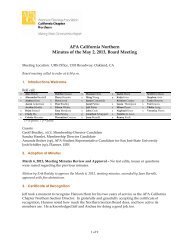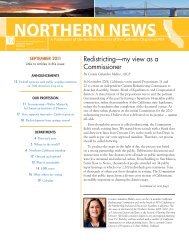Plan-it sustainably - Northern California Section
Plan-it sustainably - Northern California Section
Plan-it sustainably - Northern California Section
You also want an ePaper? Increase the reach of your titles
YUMPU automatically turns print PDFs into web optimized ePapers that Google loves.
What others are saying (continued from previous page)temporarily halting any development. The High-Speed RailAuthor<strong>it</strong>y declined to comment on the l<strong>it</strong>igation, whichchallenges the <strong>California</strong> Environmental Qual<strong>it</strong>y Act reviewof the project’s chosen route. Sacramento Superior CourtJudge Timothy Frawley will hear arguments for and againstthe Preliminary injunction Nov. 16. The judge recentlycombined into one case three challenges to the railauthor<strong>it</strong>y’s environmental planning document. The CEQAchallenge of the Merced-to-Fresno route is scheduled tostart in April. [Meanwhile,] the c<strong>it</strong>y [of Merced] is wa<strong>it</strong>ingon $600,000 in state and federal funding to begin the designphase of the high-speed rail station. The money is expectedto be approved before the end of the year.” —Joshua EmersonSm<strong>it</strong>h, “Opponents request building freeze on high-speedrail,” Merced Sun-Star, Oct. 4, 2012.Housing market improvement will continuehttp://b<strong>it</strong>.ly/QGmTog<strong>California</strong>’s housing market will continue to recover in 2013,as home sales are forecast to increase for the third consecutiveyear. The statewide median home price is forecast toincrease a moderate 5.7 percent to $335,000 in 2013.“Housing affordabil<strong>it</strong>y has never been stronger — w<strong>it</strong>hrecord-low interest rates and favorable home prices,” saidC.A.R. Vice President and Chief Economist Leslie Appleton-Young. “The actions of underwater homeowners will play animportant role in housing inventory next year, w<strong>it</strong>h risinghome prices inducing some to stay put and others to listand move forward.” (C.A.R., Oct. 2, 2012.)Water rates high in Bay Area, Sacramentohttp://usat.ly/NWCZKp“A study of residential water rates over the past 12 years findsthat crumbling infrastructure is forcing repairs from coast tocoast, w<strong>it</strong>h costs more than doubling in 1 of 4 local<strong>it</strong>ies.In three municipal<strong>it</strong>ies — Atlanta, San Francisco, andWilmington, Del. — water costs tripled or more. Monthlycosts topped $50 for consumers in Atlanta, Seattle, andSan Diego who used 1,000 cubic feet of water, a typicalresidential consumption level in many areas. Officials in[those] municipal<strong>it</strong>ies and elsewhere say actual consumptionis often lower. But conservation efforts counter-intu<strong>it</strong>ivelymay raise water rates in some local<strong>it</strong>ies. [While] water costsof any given area [vary greatly because of] differences inpopulation, geography, geology, bonding debt for infrastructurework, and other variables, what most water agenciesacross the nation share is increasing costs that makehigher bills all but inev<strong>it</strong>able.” An interactive map showspercentage increases for major US c<strong>it</strong>ies since 2000–2001.—Kevin McCoy, “Water costs gush higher,” USA TODAY,Sept. 29, 2012.BYOB (bag, preferably reusable)http://nyti.ms/QLv3cm“In more than two dozen <strong>California</strong> c<strong>it</strong>ies, grocery stores,pharmacies, and sometimes other retailers are no longerallowed to use plastic shopping bags and must chargecustomers for paper ones … [a charge] aimed at nudgingpeople to carry reusable bags when they shop. The conceptis sweeping across the most populous state two years afterthe District of Columbia adopted a 5-cent charge for paperand plastic. Tim Goncharoff, a Santa Cruz County official,said the rules were intended to make people think about thewastefulness of single-use products. ‘It’s a l<strong>it</strong>tle tickle to theconscience.’ The plastics industry is arguing that … the rulesare particularly onerous and impractical in places … wheretourists are unlikely to have packed a reusable bag. SanFrancisco [now has] one of the nation’s most far-reachingbag ordinances, banning plastic bags at all retailers — andeventually requiring they charge 10 cents for paper andcompostable carryout bags. In Santa Monica, where a10-cent charge for paper and a ban on plastic bags wentinto effect last year, the reusable bag culture has exploded,said Josephine Miller, an environmental program analystw<strong>it</strong>h the c<strong>it</strong>y. People want to be seen w<strong>it</strong>h the coolest,hippest reusable bag, she said, adding, ‘Businesses are puttinglogos on reusable bags.’ ” —Matt Richtel, “Paper or plastic?Some commun<strong>it</strong>ies say ne<strong>it</strong>her,” The New York Times,Sept. 28, 2012.Tackling climate change at new heightshttp://b<strong>it</strong>.ly/TNViF8“Scientists at the Univers<strong>it</strong>y of Strathclyde in Scotlandhave suggested an out-of-this-world solution [to combatingclimate change]. The researchers suggest an asteroid couldgrav<strong>it</strong>ationally anchor a dust cloud in space to block sunlightand cool the Earth. The idea would be to place an asteroid atLagrange point L1, a s<strong>it</strong>e where the grav<strong>it</strong>ational pull of the(continued on next page)<strong>Northern</strong> News 19 November 2012


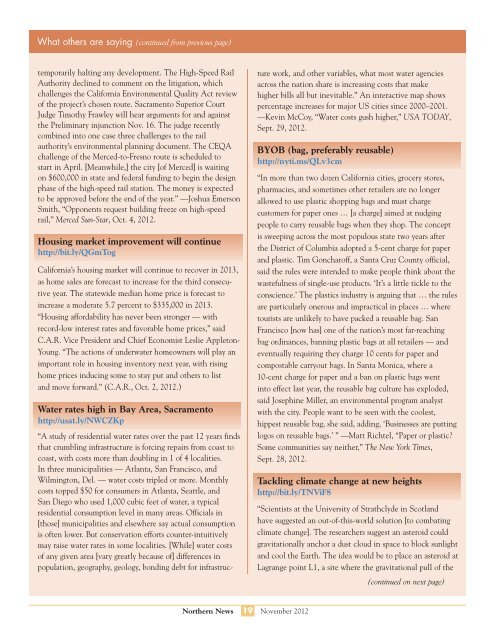
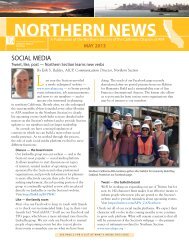
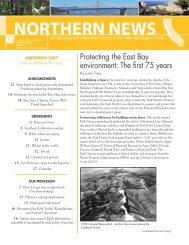
![[NAME OF EVENT] EVALUATION FORM](https://img.yumpu.com/32351925/1/190x245/name-of-event-evaluation-form.jpg?quality=85)
